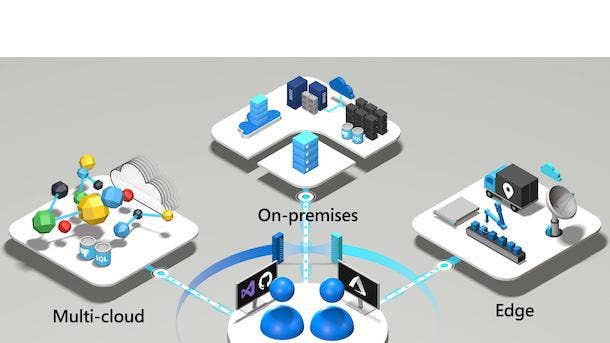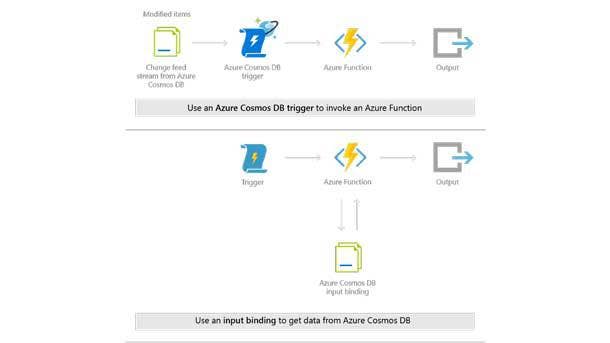6 Big Things To Know About Microsoft’s Azure Cloud Strategy
‘We always believe that the cloud is not one-size-fits-all,” said Microsoft’s JG Chirapurath. ‘Now, more than ever, customers need more choice, more flexibility, in how they approach the cloud.’

The global coronavirus pandemic has validated Microsoft’s hybrid go-to-market strategy that recognizes the cloud is not a one-size-fits-all solution and providers must meet customers where they are on their digital transformation journeys, according to JG Chirapurath, vice president of Azure data, artificial intelligence (AI) and edge.
“Our approach has not fundamentally changed,” Chirapurath said. “Ultimately, we are not just building a cloud or a product, we are solving a customer’s real business problems. While you can never completely predict the future, staying close to a customer or a set of customers really tells you the day-to-day challenges that they are dealing with. And, if anything, this pandemic has effectively brought us very close with some of our best customers.”
Chirapurath, who’s responsible for Microsoft’s databases, blockchain, analytics, machine learning (ML)/artificial intelligence (AI), Internet of Things (IoT) and mixed reality portfolio in Azure, recently talked with CRN about the No. 2 cloud computing provider’s hybrid cloud strategy.
Click through to also read Chirapurath’s thoughts on Azure’s data and AI offerings compared to those of Amazon Web Services (AWS) and Google Cloud Platform (GCP), Microsoft’s industry cloud plays, and its mixed-reality and ML/AI products and services.

Microsoft’s Azure Growth Strategy
There are just a couple of key things we’ve always been really passionate about. The first thing is we always believe that the cloud is not one-size-fits-all. Now, more than ever, customers need more choice, more flexibility, in how they approach the cloud. Whether they are sort of early in their digital transformation or they are farther along, we need to be able to provide as a company all the tools, all of the scale and, more than ever, security that they need, wherever they are in their cloud journey.
The second thing we’ve always been super passionate about is that we’ve always wanted to meet our customers and partners where they are. When you think about Azure, we want to reflect the choice that customers have in their own IT infrastructure and IT choices. To provide the broadest choice, we effectively are partner-centric and partner-centric in how we go to market. Case in point, we want to be able to tell a customer if they choose Oracle to run their database applications, that’s perfectly fine. We will absolutely work with Oracle to make sure that you know their database choices in Azure related to Oracle is the best in the world -- same with SAP. We let and help our customers choose their own journey, and we partner with our partners to help enable that.
Ultimately, it’s all about trust. Our prime mission is to continuously earn our customers’ and partners’ trust. About 95 percent of the Fortune 500 companies in the world choose Azure, and we take that trust that they put in us as sacred. We want to enable their success, so that they can innovate in our cloud in the best way they can.

Microsoft’s Hybrid Cloud Strategy
Microsoft built Azure to be hybrid from day one, so we didn’t sort of back into it. Hybrid is ultimately an operating model.
When you think about hybrid offerings, there are really two things you should effectively keep in mind. Technologies like Azure Stack and Azure Stack HCI are effectively ‘Azure in a box.’ (They provide) the Azure consistency of the infrastructure that runs in it, services that are part of it, that the customers can take and run in their data center. As part of this, we work with partners like HP, like Dell and folks like that to deliver this hardware form factor.
We also have something called Azure Arc. And Azure Arc is really a control plane, which effectively allows you to manage your infrastructure that is sitting in your data center, inside the Azure cloud. It also gives you the ability to run any Azure service anywhere that you like. In fact, it is the underpinning of our promise to be multi-cloud. What that means is you can effectively take Azure SQL…and you can run it inside AWS, you can run it inside Google should you choose to.
We believe that we have the most comprehensive sort of approach to this whole hybrid proposition. And the best part is, we are doing it in partnership with all of our partner ecosystem and with the open- source community.
If you keep progressing, you will effectively say that devices, hardware in particular, are getting more capable and getting smaller and smaller. This is where the other aspect of our partner ecosystem comes into play with Azure IoT, with all of these devices that are required to enable IoT scenarios at the edge. It’s another one of those things where it’s a complete partner-led business model for us.
So, hybrid can be multiple things depending on this scenario, but from Stack to Arc to the IoT proposition, we effectively thought about this and deployed and built it in the most comprehensive way possible that absolutely reflects our customers’ reality.

How Microsoft’s Data And AI Offerings Stack Up Against AWS And GCP
We absolutely offer a very differentiated proposition when it comes to data, analytics, AI and the edge.
From a data perspective, we’re the only cloud that offers something called Azure SQL. Azure SQL is really the perfect complement for any customer that is essentially thinking of migrating their SQL Server on premises, because it’s built with the same IP (intellectual property). Effectively, what it means is, we’re the only cloud where the customers can take their SQL Server, migrate it and modernize their SQL Server applications into Azure with really no code changes or any sort of heavy lifting.
We also offer things like Cosmos DB, which is the cloud-native database for the modern application that needs to get built. Under that one cover, customers can choose the kind of database API that they need, without having to choose between multiple services. You get Cosmos DB, it’ll serve the modern application that you’re looking to build for now and forever.
Third, from an analytics perspective, the combination of Azure Synapse and Power BI offers a very, very powerful modality for customers to deal with data of any kind, analyze it, get their insights from it. And the proposition is so powerful: Land the data in any way you wish inside Synapse, use the engine of your choice, get the insights you need, natively integrate it with Power BI so that your business analysts can visualize it in powerful and magical ways. That combination of Synapse and Power BI is really unmatched in the industry.
And finally, just from a data perspective, we also just recently announced something called Azure Purview. It is the industry’s first data governance solution that enables customers to identify the data they have, map it, understand fair use of it and really govern the use of that data from a compliance perspective.
As you start to look into things like AI -- the investments we’ve made there with Azure Machine Learning, Azure Cognitive Services and the kinds of customers (like FedEx) that are using it -- you’ll essentially see that the offerings we have there are completely differentiated.
What enhances it and continues to differentiate it is the fact that we have a robust partner ecosystem that surrounds it. Case in point, one of our most valuable partners is a company called Databricks. Databricks is a third-party company in the analytics and AI space, but they exist on Azure as a first-party service. So to us and to our customers, they are Azure Databricks -- they’re not Databricks, a third-party company. Across what we offer as our first-party services and our offerings with our partners, we stand out.

Industry Clouds
(One) of the things we’re really, really passionate about is this whole concept of industry clouds, because we believe that digital transformation has extraordinary gains to offer in any industry. If you take retail, banking, finance, healthcare, we want to essentially create these offerings that help participants in a particular industry hit the floor running.
Microsoft Cloud for Healthcare, that we just launched (in October), is a very great example of how we deliver that. And you can expect us to continue to invest in these industry-specific clouds across these verticals as sort of as a next evolution of how we see our cloud journey come around. You can expect that we will…offer these industry clouds for most industries that we participate in.
Partners are fundamentally part of our journey here. Lots of these services partners are also industry-specific. If there is a partner there that effectively offers a set of industry-specific solutions -- maybe a set of applications, maybe a set of analytics templates, maybe a collaboration model that is so industry-specific -- we absolutely are going to be working with them, just like we do in every one of our clouds, to make sure that they can…be successful with us to the service of our customers and that industry.

Mixed Reality
Mixed reality is one of those areas where we enable customers and businesses to do things that provide immersive and rich experiences, and really represent the future of how even things like collaboration, crucial tasks -- things like Remote Assist -- provide real, powerful new ways to connect to customers and partners.
Things like the HoloLens device: Think of it as really an ultimate cloud edge device, because it effectively brings together elements of things that exist in every cloud. Let me give you an example. One of the things I’m most excited about is that there’s a service that we have called Dynamics 365 Remote Assist. Remote Assist is effectively a way for you to help a customer -- or that customer to help their partners, their employees, their customers -- in a remote context. Every HoloLens device is built (and) is supported by the massive computational scale that Azure provides and the Azure services that effectively help you build applications to enable that HoloLens device. However, in this case, the application that is built and enabled is actually a Dynamics 365 application. So in that context, the potential of what we can do with mixed reality really stands out, because it can be the device that effectively stitches together all of our clouds in very, very powerful ways.
That’s an area we continue to innovate and continue to invest in, and you will continue to see powerful new scenarios like Dynamics 365 Remote Assist being enabled through this modality.

AI/ML
The other thing that I’m super excited about is the rapid growth of artificial intelligence and machine learning, and how this can be effectively employed to solve real-world business problems in almost every industry.
What the pandemic really taught us was that the use of advanced technologies like machine learning…to do things like predictive analytics has really been sort of an eye-opener for all of us. So we continue to invest in a really big way in things like Azure Machine Learning, Azure Cognitive Services and effectively enable customers to transform their digital infrastructure in ways that are profound.
It’s beyond saying that, “Hey, listen, I’m just migrating it, or I’m taking it from on premises into the cloud.” We see customers effectively saying, “Alright, we’ve done that. What’s next? Let’s figure out all of this data that we are gathering. How can we unlock real insights from it and apply machine learning techniques to it to unlock real value for us?”
The other sort of ancillary trend here is the use of edge devices -- as in devices that sit right on the edge of the network -- (that are) getting more computationally capable. Effectively, you can supply it with things like machine learning models, so that it can do inferencing at the edge. My favorite case study in this regard is a customer called Peace Parks (Foundation). These folks are the largest white rhino conservancy in the world. They’re based in Africa. To stop poaching, they turn to Azure to effectively patrol vast amounts of area, which is what the range of the white rhino is, and…use AI and machine learning techniques fitted on quadcopter drones with cameras to constantly scan the surface and take pictures and then send those pictures back to Azure. Azure Machine Learning effectively infers and alerts you if there is some suspicious activity in a zone or in a quadrant. It has helped this organization do their job better.
Two years ago, three years ago, these kinds of scenarios would have been really impossible for you to do effectively. But this is a case where technology has evolved to a point where you can apply IoT devices like cameras and drones and AI to solve something that is vital to mankind, humankind.